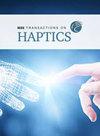A Generalized Tracking Wall Approach to the Haptic Simulation of Tip Forces During Needle Insertion
IF 2.8
3区 计算机科学
Q2 COMPUTER SCIENCE, CYBERNETICS
引用次数: 0
Abstract
Haptic simulation of needle insertion requires both a needle-tissue interaction model and a method to render the outputs of this model into real-time force feedback for the user. In comparison with interaction models, rendering methods in the literature have seen little development and are either oversimplified or too computationally complex. Therefore, this study introduces the Generalized Tracking Wall (GTW) approach, a haptic rendering method inspired by the proxy approach. It aims to accurately simulate the interaction between a needle tip and soft tissues without the complex calculations of tissue deformations. The essence of the proposed method is that it associates an algorithm based on the energetic analysis of cutting with a contact model capable of simulating viscoelasticity and nonlinearity. This association proved to be a potent tool to faithfully replicate the different phases of needle insertion while adhering to underlying physics. Multi-layered-tissue insertions are also considered. The performance and generecity of the GTW are first evaluated through simulations. Then, the GTW is experimentally compared to empirical methods inspired by the literature.针头插入过程中针尖力触觉模拟的广义跟踪壁方法。
针插入的触觉模拟既需要针与组织的交互模型,也需要将该模型的输出结果渲染成实时力反馈给用户的方法。与交互模型相比,文献中的渲染方法鲜有发展,要么过于简化,要么计算过于复杂。因此,本研究引入了广义跟踪墙(GTW)方法,这是一种受代理方法启发的触觉渲染方法。该方法旨在精确模拟针尖与软组织之间的相互作用,而无需复杂的组织变形计算。该方法的精髓在于将基于切割能量分析的算法与能够模拟粘弹性和非线性的接触模型相结合。事实证明,这种关联是一种有效的工具,可忠实地复制针插入的不同阶段,同时遵循基本的物理学原理。此外,还考虑了多层组织的插入。首先通过模拟评估了 GTW 的性能和遗传性。然后,在实验中将 GTW 与文献中的经验方法进行比较。
本文章由计算机程序翻译,如有差异,请以英文原文为准。
求助全文
约1分钟内获得全文
求助全文
来源期刊

IEEE Transactions on Haptics
COMPUTER SCIENCE, CYBERNETICS-
CiteScore
5.90
自引率
13.80%
发文量
109
审稿时长
>12 weeks
期刊介绍:
IEEE Transactions on Haptics (ToH) is a scholarly archival journal that addresses the science, technology, and applications associated with information acquisition and object manipulation through touch. Haptic interactions relevant to this journal include all aspects of manual exploration and manipulation of objects by humans, machines and interactions between the two, performed in real, virtual, teleoperated or networked environments. Research areas of relevance to this publication include, but are not limited to, the following topics: Human haptic and multi-sensory perception and action, Aspects of motor control that explicitly pertain to human haptics, Haptic interactions via passive or active tools and machines, Devices that sense, enable, or create haptic interactions locally or at a distance, Haptic rendering and its association with graphic and auditory rendering in virtual reality, Algorithms, controls, and dynamics of haptic devices, users, and interactions between the two, Human-machine performance and safety with haptic feedback, Haptics in the context of human-computer interactions, Systems and networks using haptic devices and interactions, including multi-modal feedback, Application of the above, for example in areas such as education, rehabilitation, medicine, computer-aided design, skills training, computer games, driver controls, simulation, and visualization.
 求助内容:
求助内容: 应助结果提醒方式:
应助结果提醒方式:


